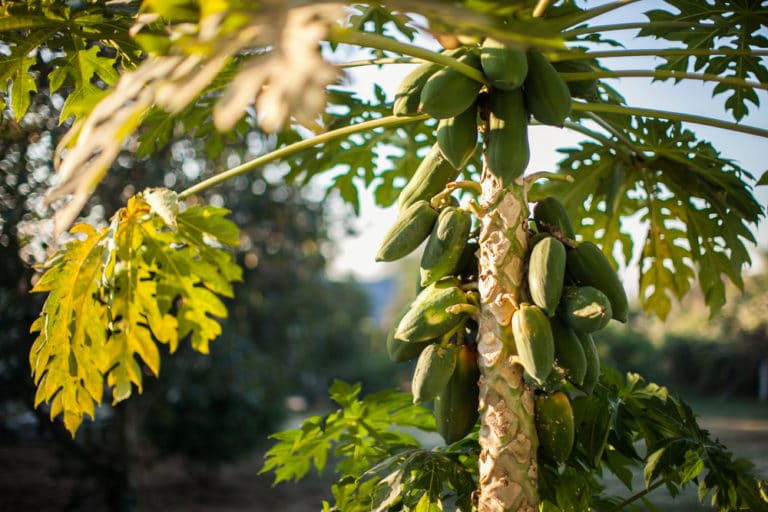
Imagine sinking your teeth into a juicy, sweet papaya, its vibrant orange flesh bursting with tropical flavor. It's a taste of sunshine, and it makes you wonder, where does this delicious fruit actually come from? Well, let's embark on a journey to discover the prime papaya-producing regions of the world!
Unveiling the Global Papaya Belt
When we ask the question "where do most papayas grow?", the answer lies primarily within the tropics. Papayas thrive in warm, humid climates with well-drained soil. This confines their primary cultivation to a "papaya belt" that encircles the Earth near the equator. This belt includes countries with consistently warm temperatures, ample rainfall, and protection from frost. Frost is a papaya tree's worst enemy.
Leading Papaya Producing Countries
Several countries stand out as major contributors to the global papaya supply. Understanding where these papayas originate gives insight into the environmental conditions and agricultural practices that favor their cultivation.
India: A Papaya Powerhouse
India is consistently ranked as one of the top papaya producers worldwide. The country's diverse climate allows for papaya cultivation in various regions, particularly in states like Andhra Pradesh, Gujarat, Karnataka, and West Bengal. Favorable weather patterns, combined with advanced agricultural techniques, have propelled India to the forefront of papaya production. Smallholder farmers are crucial for the production of papayas in India.
- Climate: Tropical and subtropical
- Key Growing Regions: Andhra Pradesh, Gujarat, Karnataka, West Bengal
- Common Varieties: Coorg Honey Dew, Pusa Dwarf, Red Lady
Brazil: South America's Papaya Giant
Brazil dominates papaya production in South America. The warm, humid climate and abundant rainfall in regions like Bahia and Espirito Santo create ideal conditions for papaya growth. Brazilian papayas are known for their size, sweetness, and vibrant color. They are sold both domestically and exported worldwide.
Brazil's success can also be attributed to its advanced agricultural infrastructure and research programs. These efforts have led to the development of high-yielding papaya varieties and improved farming practices.
- Climate: Tropical
- Key Growing Regions: Bahia, Espirito Santo
- Common Varieties: Golden, Sunrise Solo
Mexico: A Significant Papaya Exporter
Mexico plays a crucial role in supplying papayas to North American markets. The country's proximity to the United States makes it a convenient and reliable source of this tropical fruit. Papayas are primarily grown in the southern regions of Mexico, such as Veracruz, Oaxaca, and Chiapas.
Mexican papaya farmers utilize a combination of traditional and modern farming techniques to maximize yields. The industry is also focused on improving post-harvest handling to ensure the quality and freshness of papayas during transportation.
- Climate: Tropical and subtropical
- Key Growing Regions: Veracruz, Oaxaca, Chiapas
- Common Varieties: Maradol, Tainung
Other Important Papaya Growing Regions
While India, Brazil, and Mexico lead the way, other countries also contribute significantly to the global papaya supply.
Nigeria: West Africa's Papaya Hub
Nigeria is a major papaya producer in West Africa. Papaya cultivation is widespread throughout the country, providing a valuable source of income for many farmers. However, challenges such as limited access to improved varieties and pest and disease management remain.
Indonesia: Southeast Asia's Papaya Source
Indonesia's tropical climate and fertile soil make it well-suited for papaya cultivation. Papayas are grown throughout the archipelago, particularly on islands like Java and Sumatra.
Philippines: Island Nation with Tropical Fruits
The Philippines benefit from their tropical climate, providing excellent conditions for papaya growth. Local cultivars are popular, with an increasing emphasis on export-quality varieties.
Thailand: Southeast Asia and its Papaya Climate
Thailand benefits from tropical climate which is excellent for papaya cultivation. The country focuses on producing high quality papayas for local consumption, and increasingly for export.
Factors Influencing Papaya Cultivation
Several factors play a vital role in determining where papayas can thrive. Understanding these factors helps explain why certain regions are more suitable for papaya cultivation than others. In essence, several factors must be taken into account when determining the best locations for these delicious fruits.
Climate: The Key to Papaya Growth
Papayas require consistently warm temperatures, ideally between 65°F and 90°F (18°C and 32°C). They are highly sensitive to frost and cannot tolerate prolonged periods of cold weather. Ample sunshine is also essential for optimal fruit development. Regions with distinct wet and dry seasons can be suitable for papaya cultivation, provided that adequate irrigation is available during the dry season.
Soil: A Foundation for Healthy Papayas
Well-drained soil is crucial for papaya growth. Papayas are susceptible to root rot if the soil becomes waterlogged. Sandy loam soils are generally preferred, as they provide good drainage and aeration. The soil p H should be slightly acidic to neutral, ranging from 6.0 to
7.0.
Before planting papayas, farmers often amend the soil with organic matter to improve its fertility and water-holding capacity.
Water: Sustaining Papaya Production
Papayas require consistent moisture, particularly during the early stages of growth. Irrigation is often necessary, especially in regions with limited rainfall. Drip irrigation is a common method, as it delivers water directly to the roots and minimizes water waste.
Proper drainage is just as important as adequate irrigation. Papayas cannot tolerate standing water, which can lead to root rot and other diseases.
The Future of Papaya Production
As global demand for papayas continues to grow, the industry is focused on improving production efficiency and sustainability. Research efforts are underway to develop disease-resistant varieties and optimize farming practices. Technological advancements, such as precision agriculture and automated irrigation systems, are also playing a role in enhancing papaya production. The future looks bright for papaya lovers everywhere!
Conclusion: Papaya's Tropical Home
So, next time you enjoy a delicious papaya, remember its journey from the warm, tropical regions where it thrives. From India to Brazil and beyond, these papaya-producing countries are working hard to bring this sweet and nutritious fruit to your table. By understandingwhere most papayas grow and the factors that influence their cultivation, we can appreciate the effort and dedication that goes into producing this tropical delight.